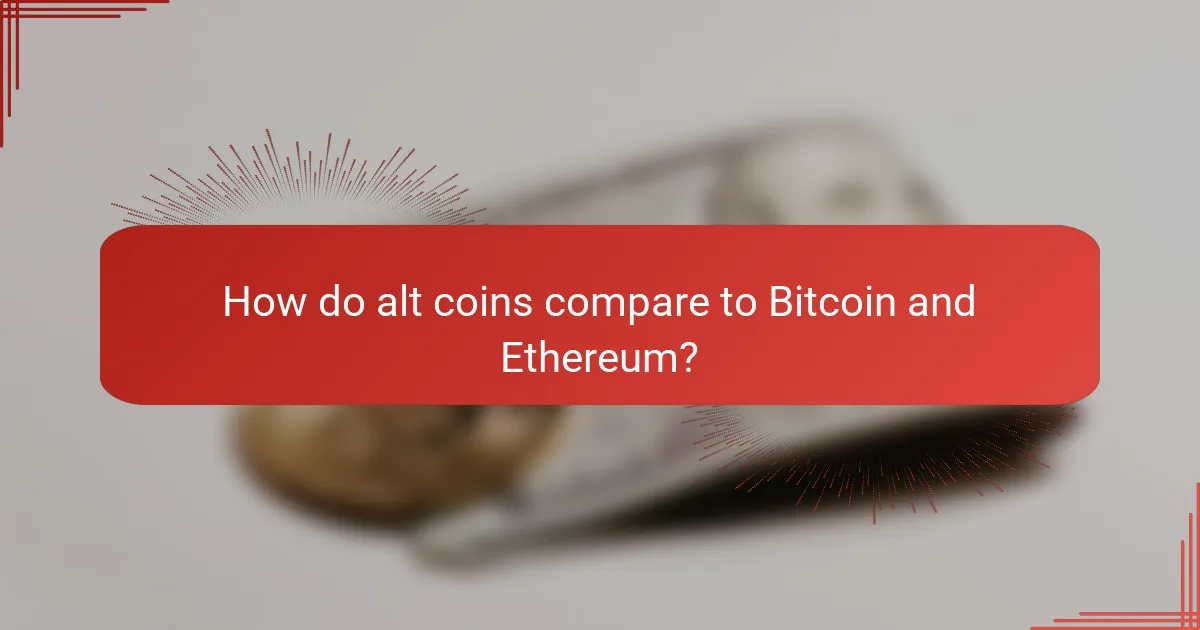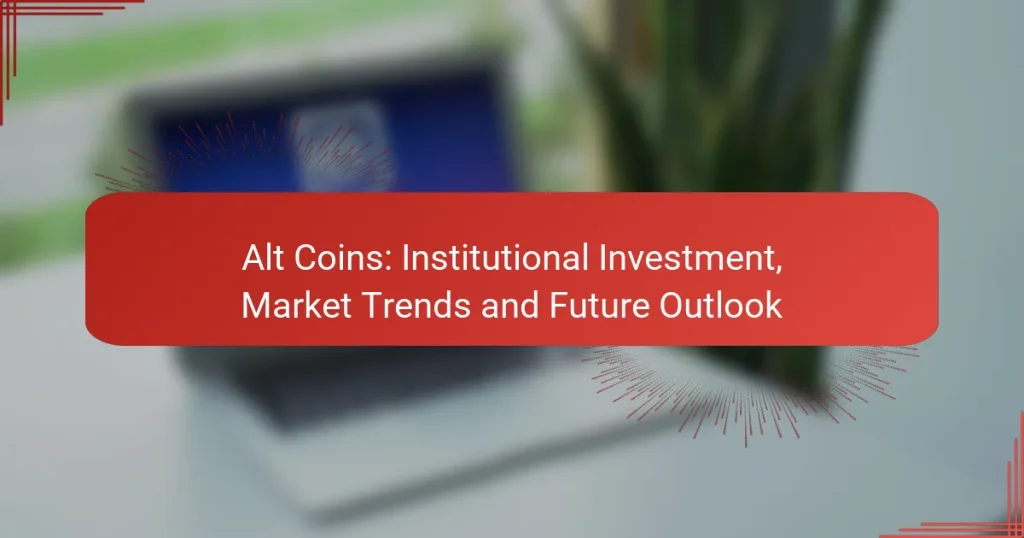The landscape of alt coins is evolving rapidly, driven by a notable increase in institutional investment, the expansion of decentralized finance (DeFi), and the rising prominence of non-fungible tokens (NFTs). As institutions diversify their portfolios beyond Bitcoin, they are employing various strategies to engage with alt coins, which is reshaping market dynamics and investor behavior. However, potential investors must remain vigilant about the inherent risks associated with this volatile market, including regulatory uncertainties and liquidity challenges.

What are the current market trends for alt coins?
Current market trends for alt coins indicate a significant shift towards increased institutional investment, the rise of decentralized finance (DeFi), and the growing influence of non-fungible tokens (NFTs). These trends are shaping the future landscape of cryptocurrency, impacting investor behavior and market dynamics.
Increased institutional adoption
Institutional adoption of alt coins has surged, with major financial institutions and corporations investing in cryptocurrencies. This trend is driven by the search for diversification and potential high returns, as well as the desire to leverage blockchain technology.
Examples include companies adding Bitcoin and Ethereum to their balance sheets, and investment firms launching alt coin funds. This influx of capital is likely to stabilize prices and increase mainstream acceptance of alt coins.
Growth in decentralized finance (DeFi)
The DeFi sector has expanded rapidly, offering decentralized alternatives to traditional financial services such as lending, borrowing, and trading. Alt coins play a crucial role in this ecosystem, often serving as collateral or governance tokens.
Investors are increasingly drawn to DeFi platforms due to their potential for higher yields compared to traditional banking. However, users should be cautious of risks such as smart contract vulnerabilities and regulatory uncertainties.
Emergence of NFTs and their impact
NFTs have gained popularity, creating new markets for digital art, collectibles, and virtual assets. This trend has positively influenced alt coins, as many NFTs are built on blockchain platforms that utilize specific alt coins for transactions.
The rise of NFTs has also led to increased interest in the underlying technologies, prompting further investment in alt coins that support NFT marketplaces. Investors should consider the volatility and speculative nature of the NFT market when engaging with these assets.
Regulatory developments in the US
Regulatory developments in the US are shaping the alt coin landscape, with agencies like the SEC and CFTC working to establish clearer guidelines. This regulatory scrutiny can impact the trading and adoption of alt coins, influencing investor confidence.
Potential regulations may include stricter compliance requirements for exchanges and clearer definitions of what constitutes a security. Investors should stay informed about these changes, as they can significantly affect market dynamics and investment strategies.
Market volatility and investor sentiment
Alt coin markets are characterized by high volatility, which can lead to rapid price fluctuations. Investor sentiment plays a crucial role in this volatility, as market reactions to news, regulatory changes, and technological advancements can drive prices up or down.
To navigate this volatility, investors should adopt a disciplined approach, setting clear entry and exit points while diversifying their portfolios. Staying updated on market trends and sentiment can help investors make informed decisions in the fast-paced alt coin environment.

How are institutions investing in alt coins?
Institutions are increasingly investing in alt coins through various strategies, reflecting a growing acceptance of cryptocurrencies beyond Bitcoin. This investment trend includes hedge funds, venture capital, partnerships with exchanges, and specific allocation percentages in portfolios.
Investment strategies of hedge funds
Hedge funds are adopting diverse strategies to invest in alt coins, often focusing on market trends and volatility. Many funds utilize quantitative trading models to capitalize on price fluctuations, while others may take a long-term approach, investing in promising projects with strong fundamentals.
Some hedge funds also engage in arbitrage opportunities, exploiting price differences across exchanges. This strategy requires sophisticated technology and rapid execution to be effective, making it suitable for well-resourced hedge fund managers.
Venture capital funding in blockchain projects
Venture capital firms are actively funding blockchain projects that utilize alt coins, seeking innovative solutions and disruptive technologies. These investments typically target early-stage companies with the potential for high returns, often in sectors like finance, supply chain, and gaming.
Investors look for projects with strong teams, clear use cases, and scalable business models. The funding amounts can vary widely, from hundreds of thousands to tens of millions of dollars, depending on the project’s maturity and potential impact.
Partnerships with crypto exchanges
Institutions are forming partnerships with crypto exchanges to gain better access to alt coin markets and enhance liquidity. These collaborations often involve exclusive trading agreements or joint ventures that allow institutions to leverage the exchange’s infrastructure and user base.
Such partnerships can also provide institutions with valuable market insights and data analytics, helping them make informed investment decisions. Additionally, they may offer institutions the ability to execute large trades without significantly impacting market prices.
Allocation percentages in portfolios
Institutional investors are increasingly allocating a portion of their portfolios to alt coins, typically ranging from a few percent to around 10%. This allocation reflects a balance between risk and potential returns, as alt coins can be more volatile than traditional assets.
When determining allocation percentages, institutions consider factors such as market conditions, regulatory developments, and the overall investment strategy. A well-diversified portfolio may include a mix of established alt coins and emerging projects to mitigate risks while capturing growth opportunities.

What are the risks associated with alt coin investments?
Investing in alt coins carries several risks that potential investors should be aware of. These include market manipulation, regulatory uncertainties, technological vulnerabilities, and liquidity challenges, all of which can significantly impact investment outcomes.
Market manipulation concerns
Market manipulation is a significant risk in the alt coin space, where trading volumes can be low and price movements can be exaggerated. Investors should be cautious of schemes that artificially inflate prices through coordinated buying or misleading information.
To mitigate this risk, consider investing in alt coins with higher trading volumes and established market presence. Researching the coin’s trading patterns and community sentiment can also provide insights into potential manipulation.
Regulatory risks in major markets
Regulatory risks are prevalent in the alt coin market, as governments worldwide are still defining their stance on cryptocurrencies. Changes in regulations can lead to sudden market shifts, impacting the legality and trading of specific alt coins.
Investors should stay informed about the regulatory landscape in their country and major markets. For instance, the European Union and the United States have been actively discussing frameworks that could affect alt coin investments, so monitoring these developments is crucial.
Technological vulnerabilities
Technological vulnerabilities pose a risk to alt coin investments, as many coins rely on complex blockchain technology that may have security flaws. Hacks and exploits can lead to significant financial losses for investors.
To reduce exposure to these risks, choose alt coins that have undergone rigorous security audits and have a strong development team. Additionally, using secure wallets and following best practices for safeguarding private keys can help protect investments.
Liquidity issues with smaller coins
Liquidity issues are common with smaller alt coins, making it difficult to buy or sell without affecting the market price. Low liquidity can lead to wider bid-ask spreads and increased volatility, which can be detrimental to investors.
Investors should assess the trading volume and market capitalization of alt coins before investing. Opting for coins with higher liquidity can provide a smoother trading experience and reduce the risk of sudden price swings when entering or exiting positions.

What criteria should investors consider for alt coin selection?
Investors should evaluate several key criteria when selecting alt coins, including market capitalization, technology, team engagement, and historical performance. These factors can significantly influence the potential success and stability of an alt coin investment.
Market capitalization and trading volume
Market capitalization reflects the total value of an alt coin and can indicate its stability and growth potential. Generally, coins with higher market caps are considered safer investments, while those with lower caps may offer higher risk but potentially greater rewards.
Trading volume is another critical metric, as it shows how actively a coin is being bought and sold. High trading volume often suggests strong investor interest and liquidity, making it easier to enter and exit positions without significant price impact.
Technology and use case evaluation
The underlying technology of an alt coin and its specific use case are vital for assessing its long-term viability. Investors should look for coins that solve real-world problems or offer unique features that differentiate them from competitors.
For example, coins that enable faster transactions or enhanced privacy features may attract more users. Evaluating the technology’s scalability and security is equally important, as these factors can affect the coin’s adoption and longevity.
Team and community engagement
The development team behind an alt coin plays a crucial role in its success. A strong, experienced team can drive innovation and respond to market changes effectively. Investors should research the team’s background, track record, and commitment to the project.
Community engagement is also essential. A vibrant, active community can provide support, promote the coin, and contribute to its development. Platforms like social media and forums can offer insights into community sentiment and involvement.
Historical performance analysis
Analyzing an alt coin’s historical performance can provide valuable insights into its price trends and market behavior. Investors should look at price charts over various time frames to identify patterns and volatility.
While past performance is not indicative of future results, understanding how a coin reacted to market events can help investors make informed decisions. Consider factors such as previous highs and lows, as well as how the coin performed during market downturns.

How do alt coins compare to Bitcoin and Ethereum?
Alt coins, which refer to all cryptocurrencies other than Bitcoin and Ethereum, often exhibit different market behaviors and use cases. While Bitcoin is primarily viewed as a store of value and Ethereum as a platform for decentralized applications, alt coins can vary widely in purpose, technology, and market performance.
Market dominance and trends
Market dominance refers to the percentage of the total cryptocurrency market capitalization that Bitcoin and Ethereum hold compared to alt coins. As of late 2023, Bitcoin typically accounts for around 40-50% of the market, while Ethereum holds about 15-20%. The remaining share is occupied by various alt coins, which are gaining traction due to innovative features and niche applications.
Recent trends indicate a growing interest in alt coins, particularly those focused on decentralized finance (DeFi), non-fungible tokens (NFTs), and layer-2 scaling solutions. Investors are diversifying their portfolios, seeking potential high returns from lesser-known coins that may offer unique functionalities or improvements over existing blockchain technologies.
To navigate the alt coin market effectively, investors should conduct thorough research on each coin’s use case, technology, and community support. Monitoring market trends and being aware of regulatory developments can also provide valuable insights into potential risks and opportunities in the alt coin space.


